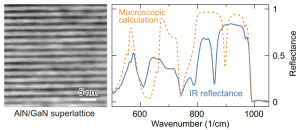
Atomic scale heterostructures offer unique possibilities for new material properties that emerge from the chemical bonding at the material interfaces rather than from the bulk. Often this idea is brought forward using two-dimensional van-der-Waals bonded crystals. In contrast here, researches show that the same concept can also be applied to traditional semiconductors with atomic-level control over the individual few-monolayer-thick sheets using epitaxial methods. The enhanced interlayer bonding strength leads to tremendous modifications of the material properties. The heterostructure behaves as a new crystal hybrid material dominated by the hetero-interfaces, with properties which cannot be derived from the individual constituents.
Using the Nitride semiconductors GaN and AlN, the authors demonstrate this concept experimentally for the first time, focusing on the optical phonons. In the crystal hybrid, new optical phonon modes emerge and others get modified significantly. These phonon modes, in turn, determine the infrared dielectric function and thereby the characteristics of phonon polaritons supported by the new material. Apart from shifted and newly emerging surface polariton bands, the strong anisotropy of the layered structure additionally introduces extreme birefringence, with several pronounced hyperbolic bands emerging. Thus, the new material provides rich physics which is absent its constituents, and which can be controlled via the layer thicknesses. This first demonstration of the crystal hybrid concept paves the way for a new era of material design for infrared-to-terahertz photonics.